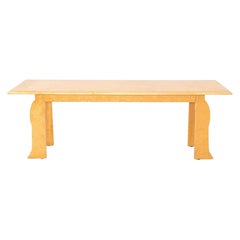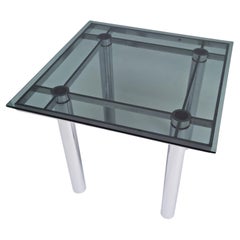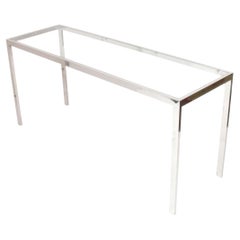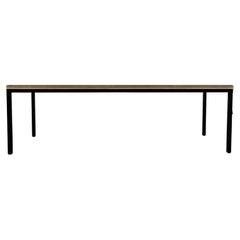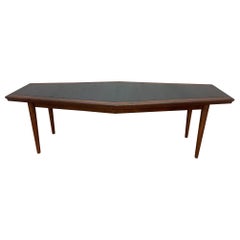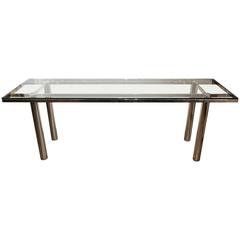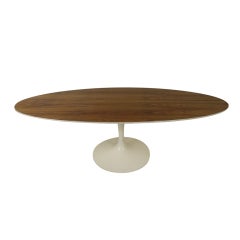Knoll Console Tables
Vintage 1980s American Modern Console Tables
Steel
Vintage 1960s Belgian Mid-Century Modern Console Tables
Steel, Chrome
Vintage 1960s American Mid-Century Modern Console Tables
Metal
Mid-20th Century American Mid-Century Modern Console Tables
Metal
20th Century American Mid-Century Modern Console Tables
Steel
Mid-20th Century Danish Mid-Century Modern Console Tables
Laminate, Walnut
Recent Sales
20th Century American Console Tables
Vintage 1950s American Mid-Century Modern Console Tables
Aluminum
Vintage 1960s American Mid-Century Modern Console Tables
Aluminum
Vintage 1970s Console Tables
Marble
Mid-20th Century American Mid-Century Modern Desks and Writing Tables
Steel
Mid-20th Century American Mid-Century Modern Console Tables
Chrome
1990s American Mid-Century Modern Console Tables
Marble, Stainless Steel
1990s American Mid-Century Modern Console Tables
Marble, Stainless Steel
Mid-20th Century German Mid-Century Modern Desks
Iron, Metal
Vintage 1960s American Mid-Century Modern Console Tables
20th Century American Console Tables
Vintage 1950s American Console Tables
Metal
Vintage 1960s Italian Pier Mirrors and Console Mirrors
Chrome
Vintage 1950s American Mid-Century Modern Console Tables
Walnut
Vintage 1960s Mid-Century Modern Stools
People Also Browsed
21st Century and Contemporary French Art Deco Stools
Iron
Vintage 1970s Spanish Mid-Century Modern Coffee and Cocktail Tables
Brass
Vintage 1940s American Mission Coffee and Cocktail Tables
Steel
Vintage 1970s German Mid-Century Modern Flush Mount
Chrome, Brass
1990s Italian Post-Modern Sectional Sofas
Metal
Vintage 1950s French Mid-Century Modern Shelves
Metal, Brass
Vintage 1940s French Art Deco Console Tables
Marble, Iron
Vintage 1970s Italian Mid-Century Modern Lounge Chairs
Bouclé
Vintage 1970s Italian Mid-Century Modern Dining Room Chairs
Metal
20th Century American Mid-Century Modern Console Tables
Brass
Vintage 1960s Italian Benches
Metal
Mid-20th Century Italian Mid-Century Modern Shelves
Bamboo, Cane, Rattan
Vintage 1980s American Post-Modern Console Tables
Wood, Paint
21st Century and Contemporary Danish Organic Modern Chairs
Leather
2010s Italian Chairs
Leather, Fabric
Vintage 1950s American Mid-Century Modern Shelves and Wall Cabinets
Walnut
Knoll Console Tables For Sale on 1stDibs
How Much are Knoll Console Tables?
Finding the Right Console-tables for You
Few pieces of furniture are celebrated for their functionality as much as their decorative attributes in the way that console tables are. While these furnishings are not as common in today’s interiors as their coffee-table and side-table counterparts, console tables are stylish home accents and have become more prevalent over the years.
The popularity of wood console tables took shape during the 17th and 18th centuries in French and Italian culture, and were exclusively featured in the palatial homes of the upper class. The era’s outwardly sculptural examples of these small structures were paired with mirrors or matching stools and had tabletops of marble. They were most often half-moon-shaped and stood on two scrolled giltwood legs, and because they weren’t wholly supported on their two legs rather than the traditional four, their flat-backed supports were intended to hug the wall behind them and were commonly joined by an ornate stretcher. The legs were affixed or bolted to the wall with architectural brackets called console brackets — hence, the name we know them by today — which gave the impression that they were freestanding furnishings. While console tables introduced a dose of drama in the foyer of any given aristocrat — an embodiment of Rococo-style furniture — the table actually occupied minimal floor space (an attractive feature in home furniture). As demand grew and console tables made their way to other countries, they gained recognition as versatile additions to any home.
Contemporary console tables comprise many different materials and are characterized today by varying shapes and design styles. It is typical to find them made of marble, walnut or oak and metal. While modern console tables commonly feature four legs, you can still find the two-legged variety, which is ideal for nestling behind the sofa. A narrow console table is a practical option if you need to save space — having outgrown their origins as purely ornamental, today’s console tables are home to treasured decorative objects, help fill empty foyers and, outfitted with drawers or a shelf, can provide a modest amount of storage as needed.
The rich collection of antique, new and vintage console tables on 1stDibs includes everything from 19th-century gems designed in the Empire style to unique rattan pieces and more.
- 1stDibs ExpertOctober 7, 2024To tell if your Knoll table is real, look for a label on the underside of the tabletop. Nearly all Knoll pieces feature marks, but the specific style of the label and the information included on it have varied over the years and from table to table. As a result, you should try searching trusted online resources for images of the labels found on authentic tables of the same age and model as your own. Alternatively, you can have a certified appraiser or knowledgeable antique dealer evaluate your piece. On 1stDibs, explore a diverse assortment of Knoll tables.
- 1stDibs ExpertNovember 13, 2024Why it is called a console table comes down to the history of this type of furnishing. The very first consoles produced in France during the 16th and 17th centuries were not freestanding. Instead, owners anchored them to walls. This anchoring method strengthened the console top, allowing it to support heavy loads. The name “console” comes from the French word "consolide," which means to reinforce or strengthen. It was likely chosen because of the anchoring system that lends strength to and reinforces consoles. Shop a diverse assortment of console tables on 1stDibs.
- Why are console tables so low?1 Answer1stDibs ExpertMay 5, 2023Console tables are not low. Typically, consoles are about the height of a desk but are much narrower. As a result, they work well against walls and can be used to hold lamps and decorative objects. While modern console tables commonly feature four legs, you can still find the two-legged variety, which is ideal for nestling behind the sofa. Some also feature shelves for display and storage space or cabinet doors and drawers for hiding clutter. Find vintage console tables on 1stDibs.
- 1stDibs ExpertFebruary 22, 2021Console tables serve a variety of functions. They can be used as buffets, storage units and display tables. Because they vary in size, you can use them for just about anything.
- 1stDibs ExpertAugust 20, 2024The difference between a buffet table and a console table comes down to size and storage features. Console tables are usually less deep than buffet tables, so they take up less space behind sofas and along walls. In addition, consoles are less likely to have cabinets and drawers than buffet tables, which are designed to store dinnerware and serveware in dining rooms. On 1stDibs, explore a wide variety of buffets and console tables.
- 1stDibs ExpertOctober 7, 2024The difference between a coffee table and a console table is in the design. A coffee table is a low table that comes in many shapes, such as surfaces that are rectangles, squares, ovals or circles. Console tables are taller and usually have elongated shapes, such as ovals, rectangles or semicircles. Placement is another differentiator between the two types of tables. Coffee tables usually go in front of sofas and loveseats, while console tables may be placed behind a sofa or loveseat or along a wall. Find a large collection of coffee tables and console tables on 1stDibs.
- 1stDibs ExpertMarch 22, 2024
A lamp for a console table should be between 25 and 32 inches tall. The table lamp’s shade shouldn’t exceed half the width of the console table.
You’ll find that when it comes to arranging wall art, a decorator might suggest that the space on the wall above a console table is a great place for a large painting or a wall sculpture. In that case, you may wish to use a taller lamp for the table. If your table is smaller in scale or if you have a small mirror hanging on the wall above the console, you may wish to opt for a shorter lamp.
Find vintage table lamps for sale on 1stDibs. - 1stDibs ExpertFebruary 22, 2021Because of their variety of sizes and range in function, console tables can easily work as a desk. Given their size and ease of mobility, a console table can be used in almost any sort of room.
- 1stDibs ExpertAugust 26, 2024The difference between a sideboard and a console table comes down to usage and storage features. Sideboards are usually found in dining rooms and have shelving concealed behind cabinet doors for storing dinnerware, glassware and serveware. Normally positioned in entryways, hallways and living rooms, console tables may have no storage features or include drawers, open shelves or cabinet doors, depending on their design. Find a large selection of console tables and sideboards on 1stDibs.
- 1stDibs ExpertMay 22, 2019
The main difference between a console and a sofa table is that a console can be placed anywhere in the home (against a wall in a hallway or under a television in the living room) and a sofa table is limited to being behind a sofa.
- 1stDibs ExpertMay 22, 2019
A console table should not be taller than a couch. Much like a sofa table, a console table is placed against the back of a sofa and should be the same height as the sofa.
- 1stDibs ExpertMay 5, 2023In an entryway, a console table should typically be around 10 to 16 inches wide. Tables of this width should still allow plenty of clearance so people can easily walk by the table. You may see manufacturers refer to the width of consoles as depth. On 1stDibs, shop a range of console tables.
Read More
The Ultimate Guide to Types of Tables for the Home
Whether you’re just moving in or ready to give your home a makeover, our guide will give you pointers on tables that are fitting for every room, nook and hallway.
May’s Most Popular Interiors on Instagram
Our feed is filled with the world's most beautiful spaces. See the rooms our followers have deemed the best of the best this month.
New Orleans’ Lee Ledbetter Makes Design Magic by Mixing Past and Present
The Louisiana-born and -bred architect talks to 1stdibs about the art of making timeless places that matter.
Desert Modern Designer Arthur Elrod Finally Gets His Day in the Sun
The Palm Springs interior decorator developed a mid-century style that defined the vacation homes of celebrities and other notables, including Bob Hope and Lucille Ball.
From the Hamptons to Palm Springs, FormArch’s Homes Embody Both Comfort and Cool
The houses from this New York studio cloak modernist tendencies within what are often more traditional trappings.
